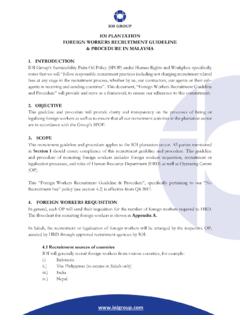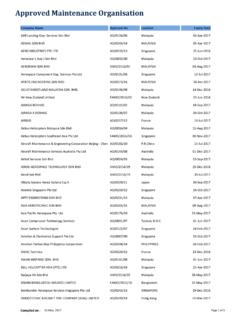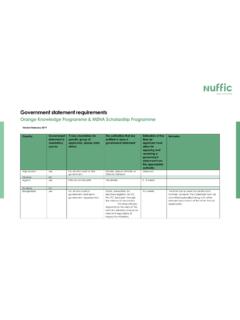Transcription of Pay and Non-Pay Incentives, Performance and Motivation
1 Round Table Discussion Pay and Non-Pay incentives , Performance and Motivation Prepared for WHO s December 2000 Global Health Workforce Strategy Group, Geneva Orvill Adams, BA (Hons), MA (Economics), MA (International Affairs); V Hicks Department of Organization of Health Services Delivery, World Health Organization, Geneva Abstract This paper provides an overview of evidence of the effects of incentives on the Performance and Motivation of independent health professionals and health workers. incentives are viewed in the context of objectives held by paying agencies or employers.
2 The review defines the nature of economic incentives and of non-financial incentives . Particular attention is paid to the need for developing countries to understand the impacts of health reform measures on incentives . A review of current literature found that the response of physicians to economic incentives inherent in payment mechanisms appears to follow directions expected in theory. Incentive structures are becoming more complex, however, as a result of managed care and blended payment mechanisms. There is insufficient evidence of the effects of incentives on Motivation and Performance of other health workers, due perhaps to a preoccupation of researchers with economic responses.
3 incentives must be viewed in a broad context in order to understand constraints and success factors that affect their prospects of success. Health human resources should be seen as a complex and interrelated system where incentives aimed at one group of professionals will impact on the entire system. Introduction The World Health Report 2000, Health Systems: Improving Performance defines incentives as all the rewards and punishments that providers face as a consequence of the organizations in which they work, the institutions under which they operate and the specific interventions they provide (1).
4 This definition suggests that the organization, the work that is done and the setting in which work takes place will determine the incentive used and its resulting impact. Buchan et al add another dimension by defining an incentive in terms of its objective: An incentive refers to one particular form of payment that is intended to achieve some specific change in behaviour (2). This review is intended to provide an overview of the current evidence on the effect of pay and Non-Pay incentives on health workers Performance and Motivation .
5 The literature on incentives is primarily focussed on the impact of specific incentives on provider behaviour, especially physicians. There is much less work on the structural and organizational aspects of incentives . This paper primarily uses as its base two papers recently completed for WHO and in publication: (1) Incentive and Remuneration Strategies in Health Care: A Research Review (Buchan et al); (2) The Effects of Economic and Policy incentives on Provider Practice (Hicks and Adams) (3). The first paper is based on a search of English language publications, using library and CD-ROM facilities.
6 The review as reported by Buchan et al covered the following databases: Social Science Citation Index (SSCI), BIDS, CHNAHL, Psyc Lit, FirstSearch, Medline and Health Management Information Consortium (HMIC). A total of 352 articles and papers were identified. The paper by Hicks and Adams is based on ten country case studies using a common framework for analysis developed by WHO. The countries in the study (Bahrain, Bangladesh, C te d Ivoire, Estonia, Ghana, Islamic Republic of Iran, Kyrgyzstan, Mongolia, Nepal and New Zealand) have all undergone health policy 2 changes in the past decade which explicitly addressed incentives , especially in regard to providers.
7 These two very different approaches for collecting evidence and experiences are augmented by a selected set of recent studies that focus primarily on incentives and their impacts. The paper is organized in three sections. The first presents the range of both pay and Non-Pay incentives and begins to link incentives to objectives. The second presents a review of evidence about the impact that incentives have on provider behaviour and the third section outlines some of the key factors in making incentives more effective.
8 Range of incentives Buchan et al offer the following typology of incentives that can be included in remuneration packages. They define remuneration as the total income of an individual and may comprise a range of separate payments determined according to different rules (page 5). Payments in this context refer to both financial and non-financial incentives . Table 1 Typology of incentives . 1. Financial A. Pay B. Other direct financial benefits Pensions Illness/health/accident/life insurance Clothing/accommodation allowance Travel allowance Child care allowance C.
9 Indirect financial benefits Subsidized meals/clothing/accommodation Subsidized transport Child care subsidy/cr che provision 2. Non Financial Holiday/vacation Flexible working hours Access to/support for training and education Sabbatical, study leave Planned career breaks Occupational health/counselling Recreational facilities Source: Buchan J et al, 2000.(2) Chaix-Couturier et al (2000) in a systematic review of the effects of financial incentives on medical practice initially identified 130 articles on the subject and accepted 89 that met their defined criteria(4).
10 They offer a typology of financial incentives inherent in different types of remuneration. The principal difference between the two approaches is their scope, with the typology used by Buchan et al comprising a total pay and benefit package and Chaix-Couturier et al focussing on types of payment that are typically used to remunerate physicians for providing medical care. The Chaix-Couturier approach is more in line with common interpretations of physician remuneration systems as incorporating one or more of four strategies: capitation, shared financial risk, fee-for-service and salary.














